
Living the Tiki lifestyle once conjured the gentle sound of distant waves and lilting ukuleles, the rustic comforts of a poolside hammock beneath swaying palms. Those drawn to this Polynesian fantasy decorated their living rooms with bamboo furniture and learned the steps to native dances, while cultivating a taste for exotic foods and sweet rum cocktails. In the mid-20th century, such tropical trends offered a viable escape for those tired of the constraints of capitalism and Western religious morals: At its heart, American Tiki worship reflected a longing for life outside the stressful confines of urban America, a desire to connect with the majesty of nature, as well as the baser pleasures of food, drink, music, and sex.
Tiki culture actually owes its existence to the intersection of complex forces, ranging from the tall tales favored by European explorers and World War II veterans to the wider appreciation of native art forms, like the carved wooden idols common to Polynesian islands. Today, the Tiki trend is viewed as pure mid-century kitsch, like the maraschino cherry on your happy-hour Mai Tai. But Americans haven’t lost their lust for the tropical lifestyle, as evidenced by Hawaii’s multibillion-dollar tourism industry—we simply confine it to the rare vacation, rather than embracing Tiki culture as part of our daily lives.
“The Western world wanted to capture paradise so badly, they destroyed it in the process.”
Sven Kirsten is among the first to recognize the American obsession with Polynesia as something bigger than the campy films and tropical nightclubs dominating the mid-20th century. A self-proclaimed “visual junkie,” Kirsten moved to California in the 1980s to work in film, and soon came upon his first relics of the mid-century Tiki phenomenon. “I lived in the Hollywood Hills and found this great store called Sea and Jungle just over the hills in Glendale,” says Kirsten, where he became instantly hooked on the vintage style. The shop had a huge inventory of Tiki memorabilia, including an entire black-light room, but it closed before Kirsten could amass much of a collection.
As he continued searching for vintage Tiki treasures in Los Angeles, Kirsten noticed the ways this Polynesian appropriation saturated all facets of American life—in bars, bowling alleys, and even bedrooms. Eventually, he met other Tiki fanatics, and realized that he knew more than most about the subject. Since then, Kirsten has worked on five books devoted to the topic, tracing the elusive Tiki trend back to its primary sources and developing an extensive personal collection of ephemera in the process. Kirsten’s latest book, “Tiki Pop,” coincides with an exhibition of the same name at the Musée du quai Branly in Paris, running through September 20th, both of which cover the full arc of our Polynesian fantasy. We recently spoke with Kirsten about the origins of the Tiki trend and its lasting impact on American culture.

Top: A rendering of the Mai-Kai restaurant in Fort Lauderdale from 1956. Above: The Tiki Apartments in Redondo Beach, California, as seen in 2012, via the Wacky Tacky.
Collectors Weekly: Where did the word “Tiki” come from?
Kirsten: Tiki was a mythological figure in Polynesia, a region defined by the Polynesian Triangle: There’s Hawaii in the north, Easter Island in the east, and New Zealand in the southwest. In the middle of that triangle are islands like Tahiti and Samoa. All of these islands share some common heritage and a similar language. They also had a religion based on ancestor worship, where their ancestors were deified in stories and myths and became their gods.
Tiki was like the Polynesian Adam, the creator of man, but he was sort of half-man and half-god. Eventually, all carvings and depictions that had human features became known as Tikis. The word “Tiki” was used in the Marquesas and by the Maori in New Zealand. In Hawaii, they’re called Ki’i, and in Tahiti they’re called Ti’i, because of the language variation. For example, the Hawaiian word for Tahiti is Kahiki (which was also a great restaurant in Columbus, Ohio), because the T becomes a K in Hawaiian. But that didn’t really matter to the Americans in the 1950s—basically all the different carving styles became members of the happy Tiki family, including the Easter Island Moai statues.

Left, an illustration of Easter Island natives by Pierre Loti, circa 1872. Right, a mid-century sculpture in the Maori style used at the now-defunct California amusement park “The Tikis.”
Collectors Weekly: How was this Polynesian style popularized in the West?

This illustration for the 1923 edition of Herman Melville’s “Typee” by Mead Schaffer captures the Western male fantasy of Polynesian life.
Kirsten: As soon as these islands were discovered by the Western world, the reports of explorers were embellished and idealized, like those by navigator Louis Antoine de Bougainville and captain James Cook about the half-naked wahines, or native women. These tales inspired Western philosophers to criticize the “civilized” world for its limitations, and that, in turn, inspired the first writers and artists, like Herman Melville and Paul Gauguin, who reinterpreted the fantasy in their own way.
Eventually, a whole new generation of authors like Jack London and Robert Louis Stevenson started writing about the South Seas. Although these were more adventure stories, they captured the imaginations of their Western audience. These books were eventually made into movies, and as entertainment culture shifted from the written word to the visual, those films had an even stronger impact on audiences and this Polynesian fantasy became even more artificial.
That was during the first part of the 20th century, continuing with the Hawaiian music craze in the ’20s and ’30s up through the 1950s. But by the late ’50s, the term “South Seas” had become old-fashioned. Tiki culture as we think of it today didn’t really start happening until 1955, and it only lasted 10 short years. It started to wane around 1965.

A 1940s placemat from the Hollywood Tropics lounge illustrates the collision of film sets and nightlife.
Collectors Weekly: What was the initial appeal of this Polynesian fantasy to Westerners?
Kirsten: It was basically the supposed lack of stress. Herman Melville’s father had been a successful businessman who hit hard times and went bankrupt, so Melville wrote in his book Typee about Polynesia as a place where there were no money lenders or creditors to haunt you, that being one aspect of the stresses and restrictions of Western civilization. Of course, the critique also included the strict sexual morals of a puritan society, compared with the laissez-faire attitude towards sex in Polynesia, where it was viewed more like eating and drinking. That was, of course, strongly appealing for the male part of the population. But it was also just the ability to live in a climate that wasn’t harsh, where you didn’t have to fend for your survival so much.
Collectors Weekly: How did the experience of soldiers stationed in Polynesia during World War II fit in with this fantasy?
Kirsten: The truth is that the South Seas myth existed before World War II and after World War II. It just proved to be more enticing than the reality of many American GI’s in the South Seas, which was much less paradisiacal. Many of them were killed as they first stepped on the beach. It wasn’t pretty. If you were stationed somewhere in Papua New Guinea, it was hot and sweaty and mosquito-infested, and there wasn’t any Martin Denny music playing in the background.

Michener’s “Tales of the South Pacific” went from adventure story to generic romance as the book was adapted for the stage and screen.
But there were those lucky men who got stationed on lovely islets and atolls behind the major lines of battle, and one of them was James Michener. In his original book, Tales of the South Pacific, which became a Pulitzer Prize-winning bestseller in 1947, Michener included chapters of strife and action on the front, but that all fell by the wayside when the musical “South Pacific” was eventually made. In a musical, you want romance and singing and dancing and not people getting their heads blown off.
But that musical produced a number of hit songs. One writer said that at the time, you couldn’t escape these songs from “South Pacific”: They were played in every elevator, in every store, and they re-popularized the South Seas myths, one of which was of the musical’s fictional tropical island, Bali Ha’i. After “South Pacific” became such a hit, Bali Ha’i bars opened in several cities across the United States. Then the musical became a movie in 1958, which perpetuated the whole thing all over again.
The other factor was that World War II veterans often suppressed the horror they saw. I talked with many veterans’ relatives who said their grandpa or dad didn’t really want to talk about the violence they had seen. But they liked cocktails and exotic restaurants as much as the people who hadn’t been there. It was like, “Let’s emphasize the fun side of it and forget about the hardships.”
Collectors Weekly: Who moved Tiki culture from the big screen into bars and restaurants?
Kirsten: It started with Ernest Gantt who came to Hollywood in the 1930s from Hawaii, where he had sailed around for a few years. Gantt brought back a bunch of souvenirs and objects that he rented to the film studios as décor for South Seas films. In 1934, he decided to open the Beachcomber Café, recasting himself as Don the Beachcomber. Because he had contacts at all the studios, the bar was frequented by Hollywood actors, which he used to help advertise the place.

Left, a mock sign on the set of a Polynesian film in Hollywood. Right, Ernest Gantt, or Don the Beachcomber (center, in 1946), made his exotic parties the envy of all America.
By the 1940s, Gantt was so successful he was hosting these lavish luaus in the backyard of his home in Encino, California. These celebrity-filled parties were covered by “Life” magazine, which was on every kitchen table in America at the time. As the trend spread, other people hired film craftsmen to help them build restaurants and lounges. I’ve even seen examples of actual film sets being turned into bars, like Christian’s Hut on Catalina Island. That was a set that was converted into a real bar after they wrapped the Clark Gable version of “The Bounty,” and it was so successful they opened four or five other locations in Southern California.
Collectors Weekly: What were the major elements of this imitation tropical lifestyle?
Kirsten: Starting with the construction of the early pre-Tiki lounges, they used all-natural materials to make people feel as far away from the concrete, steel, and glass environments most people lived and worked in. They used bamboo, rattan wallpaper, palm fronds, and tapa-cloth, which was this natural tree bark beaten into a sort of paper and printed with graphic Polynesian patterns. You would feel like you walked into a grass hut, a very organic environment.

The interior of the Luau Beverly Hills in 1950 shows a mix of the tropical Tiki, beachcomber, and trader aesthetics.
They also decorated with props relating to characters like the beachcomber. In the islands, beachcombers were usually dropouts from ships or castaways that decided not to return to civilization. They liked life on the beach, subsisting on what they could find, so anything like driftwood, seashells, or fishing nets were part of the beachcomber look.
Another popular character from the real South Seas was the trader, who was less of a hippie like the beachcomber, but still sort of a dropout from Western civilization. Traders were people who decided to stay on the islands and be this intermediary between natives and Westerners. They often had their own little sailing ships and would go from island to island, bringing back items to trade to the Westerners. So nautical elements were part of the trader look—ship’s wheels, ship’s lamps, nautical ropes, and those kinds of props.

Left, a 1952 ad for the Ritts Company’s rattan furniture shows the South Seas style invading the mid-century home. Right, the interior of the Trader Vic’s in Beverly Hills, circa 1955.
Collectors Weekly: Was the American Tiki fantasy attractive because of this alternative, bohemian vibe?
Kirsten: Yeah, I think it’s so interesting how the hippie children looked down on previous generations that grew up between the World Wars, even though the fantasies of those previous generations also had elements of proto-hippie culture. Both the pre-Tiki and the Tiki generations had this fantasy of free love and living the leisure life. Their children made it much more a reality, yet they didn’t realize that their parents had the same kind of dreams.
“It was hot and sweaty and mosquito-infested, and there wasn’t any Martin Denny music playing.”
The bohemian aspect, in terms of style and decor, was clearly part of the beachcomber look—the guy in tattered clothes who built his shack from found objects and natural materials like bamboo and driftwood. It became this escapist thing for urbanites to go to these places and feel bohemian for a while. If you look at 1930s photos of restaurants like Trader Vic’s in Oakland or Don the Beachcomber in Los Angeles, these places were full of jetsam and flotsam that didn’t exist in the normal, mid-century home at the time.
It was like a film set that people walked into; it was a construct from the very beginning. There was no larger movement of people that really went and lived like that. It was just the paraphernalia and spirit of it that was utilized in these restaurants, and made it appealing to mainstream Americans.
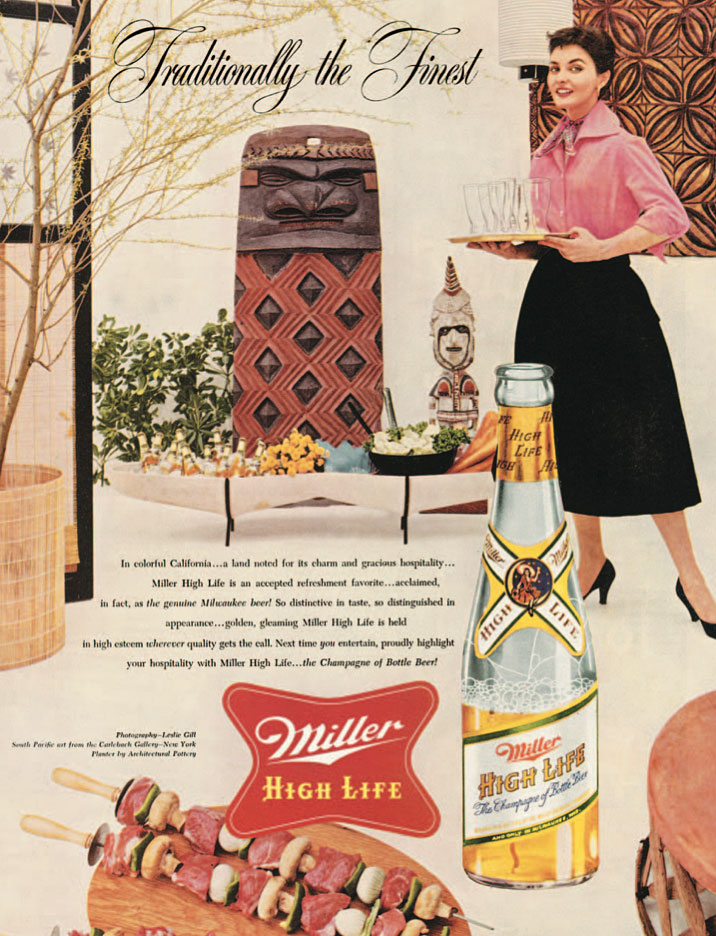
By the mid-1950s, even mass-market brands like Miller beer adopted the Tiki image to make its products seem modern and carefree.
Collectors Weekly: How did Tiki sculptures become a symbol of the fantasy?
Kirsten: Tiki imagery was inspired by carvings that artists and designers found in museums or art books. The change from Polynesian-style bars to Tiki bars was paralleled by a growing appreciation of the primitive arts in America after World War II. In Europe during the 1920s, modern artists like Picasso found inspiration in primitive art from Africa and Oceania, realizing their work didn’t need to be realistic or naturalistic. Those artists went wild and distorted the human form in a very subjective way.
“It became this escapist thing for urbanites to go to these places and feel Bohemian for a while.”
When the Nazis were marching across Europe in the 1940s, a lot of those artists emigrated to New York, bringing their aesthetic sensibility with them. In 1946, the first major exhibition of original South Seas art was shown at the Museum of Modern Art in New York. “Life” magazine did a multiple-page article in full color about the show. Images from that article and the show’s catalog were taken and used for magazine illustrations, on record covers, and, later, for Tiki bars.
The main Trader Vic’s icon is a Papua New Guinea mask with crossed spears, and it was copied out of the MoMA catalog, which designers used as their blueprint. What makes the American Tiki its own genre is that often, these artists reinterpreted those original sculptures or photos and made them their own by adding a dash of modernism or a cartoon-look to it. They did that with carvings and menu illustrations and Tiki mugs.
Another specific example is the Maori sculpture that came to San Francisco as part of the California Midwinter Exposition in 1894. After the exposition ended, the Tiki ended up on permanent display at the de Young Museum. When the Beverly Hills Trader Vic’s opened in 1955, they used that Tiki on the menu cover for the first time. Trader Vic’s used the Tiki image liberally from the mid-1950s on, and a lot of the designs were based on that particular Maori sculpture in San Francisco. Because Trader Vic’s was one of the shining examples of success, others like the Kona Kai restaurants and the Marriott hotels thought this Tiki had good manna, so they swiped it. That’s the chain of transmission.

Left, the original Maori Tiki exhibited at the California Midwinter Exhibition in 1894. Right, a Trader Vic’s menu from the 1950s featuring a stylized version of the Maori Tiki.
Collectors Weekly: Were the menus at these places inspired by actual Polynesian cuisine?
Kirsten: No, they were completely made up. Really, the food that existed on Polynesian islands was very primitive, and no American would want to eat poi [mashed taro root]. Don the Beachcomber served the only exotic cuisine that was available in America in the 1930s, which was Chinese food. He just added some pineapple, called it “Chicken Hawaiian,” and that was that.
The food wasn’t really the important thing; it was the drinks that brought people in. With the end of Prohibition, rum was really cheap, so Don the Beachcomber started mixing and experimenting, blending different rums together in drinks and adding different tropical juice flavors, and so on.
One of the few cocktails that actually started in the South Seas was called the Dr. Funk, named after Robert Louis Stevenson’s doctor in Samoa. At the time, Samoa was under German colonial rule, and Funk was a German doctor who lived there and made this concoction out of limes and absinthe, and it was served at a place he frequented in Tahiti. From there, it spread to the Western world, and Trader Vic’s and other establishments made their own versions of it.

This cocktail menu from Ren Clark’s Polynesian Village, circa 1962, shows the variety of decorative mugs used at Tiki bars.
Collectors Weekly: Did Tiki spread beyond the service industry?
Kirsten: Yes. I don’t think Tiki really became a significant pop genre until it left the bar and restaurant culture in the mid-1950s and was used for places like apartment buildings, bowling alleys, and motels. All the elements from the A-frame architecture to the bamboo trimmings to the Tiki carvings were applied to various buildings to represent leisure, fun, and escapism. One of the stranger applications was for beauty and hair salons that used the theme, like the Head Hunter Beauty Salon off Miami Beach.
But clearly, the most iconic product of the trend was the Tiki mug. They are like pottery shards of the urban jungle, evidence of Tiki temples that don’t exist anymore (many of them have the name of the Tiki bar and city they came from imprinted on the mug). You could usually take them home as souvenirs, so they were included in the cocktail price.
Collectors Weekly: How did the Tiki architectural style work with Modernist design?
Kirsten: There were two dominant forms of Modern architecture. One was the European international style from Gropius and Neutra, like the simple glass box. And then there was Googie, the coffee shops of Armét & Davis with their Space Age, organic shapes. The A-frame became very popular for commercial buildings, and was also used for these new churches to appeal to this mid-century generation after the war. It was a Space Age shape, a sign of the times.
Curiously, the A-frame also happened to match some of the architecture styles in the South Seas, especially in Papua New Guinea and Palau, where the natives built these grand meeting halls with soaring gables. Tiki-influenced architects used that style for apartment buildings, restaurants, and motels. The clash of these extreme opposites created a wonderful mixture, like the Jetsons meets the Flintstones.

Oversized Googie architecture meets traditional Polynesian A-frame at the Kahiki in Columbus, Ohio, circa 1961.
Collectors Weekly: What was the impact of Hawaiian statehood on the Tiki trend?
Kirsten: That was really huge. When Hawaii became a state, Americans felt that now they owned this place and wanted some of it in their own backyards, making it part of the American way of life. I think that’s what caused this major influx of money spent on Tiki culture, with developers building these apartments and motels in the Tiki style. Hawaii became a state in ’59, and that was the great “aloha” moment of money and development on the American mainland. You can look at the building dates for these places and they’re almost all around 1960.
Collectors Weekly: What led to the demise of Tiki style?
Kirsten: It was really the generation gap of the mid-1960s. Never before or after has there been such a rift between generations as there was in the 1960s. Everything that the parents of that generation did or embodied became totally un-hip and politically incorrect. Tiki style was, in part, viewed as being racist and sexist even though the generation before had celebrated it out of a pure love and fascination with this culture, rather than an expression of imperialism. Teens of the 1960s were sick of all the wrongs that their parents’ and grandparents’ generations had committed, these crimes of colonialism and the destruction of Native American culture.

Left, by the 1970s, many Tiki-style businesses were viewed as passé. Right, the Vietnam War helped dispel America’s romanticized notions of the tropics.
The irony of it all is that the Western world wanted to capture paradise so badly, they destroyed it in the process. On an intellectual level, we realize that island cultures have many complex problems and are not the paradises we make them out to be, but there is still this emotional need for a paradise on earth. In terms of the Tiki revival, I think that creating your own little Tiki bar, while knowing it’s a make-believe thing, somehow satisfies your emotional need for this fantasy.
I opened my “Hunters and Collectors” chapter in The Book of Tiki with a quote by the collector Henry Mercer from 1898. “At first, illustrating a humble story, the objects unfold by degrees a wider meaning, until at last the heart is touched.” That’s what I hope my work with Tiki has shown: Out of a bunch of jetsam and flotsam of 20th-century pop culture, this whole phenomenon forms in front of your eyes.
Collectors Weekly: What’s your favorite remnant of the Tiki era that’s still around?
Kirsten: Well, the grandest one is definitely the Mai Kai in Fort Lauderdale. It’s fantastic because it hasn’t been renovated in decades, and it still operates with the huge cocktail menu of rum drinks and a full floor show with all the dancers and musicians performing. Plus the food is great. But I’m in Los Angeles, and that’s a little bit far away. I go to the Tiki-Ti bar here, which is like eight minutes from my house, and enjoy one of the more than 80 tropical drinks on their menu.
(All images courtesy Sven Kirsten and Taschen. If you buy something through a link in this article, Collectors Weekly may get a share of the sale. Learn more.)

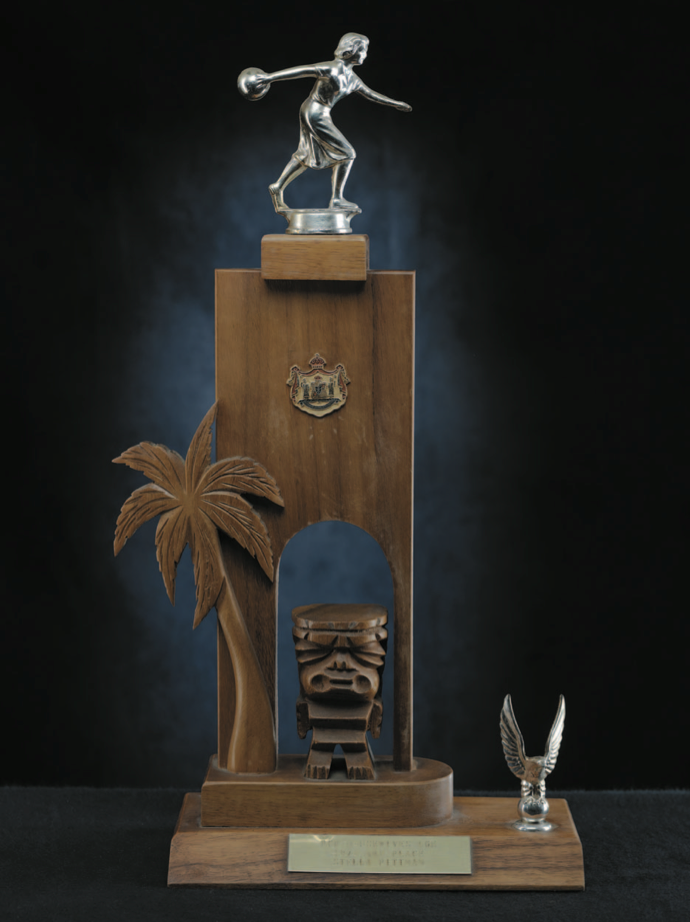

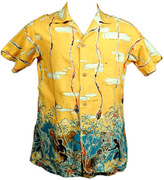
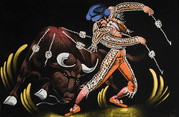 Velvet Underdogs: In Praise of the Paintings the Art World Loves to Hate
Velvet Underdogs: In Praise of the Paintings the Art World Loves to Hate
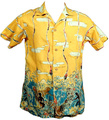 Hawaiian Style: The Roots of the Aloha Shirt
Hawaiian Style: The Roots of the Aloha Shirt Velvet Underdogs: In Praise of the Paintings the Art World Loves to Hate
Velvet Underdogs: In Praise of the Paintings the Art World Loves to Hate Collectors on a Mission: When Americans Saw the World Through Evangelists' Eyes
Collectors on a Mission: When Americans Saw the World Through Evangelists' Eyes UkulelesJust about every major guitar maker has produced a ukulele (often misspelle…
UkulelesJust about every major guitar maker has produced a ukulele (often misspelle… Hawaiian ShirtsSome people find them gaudy, others consider them tacky, but few things rep…
Hawaiian ShirtsSome people find them gaudy, others consider them tacky, but few things rep… Tiki MugsThe word tiki most often refers to an enigmatic humanoid figure intended to…
Tiki MugsThe word tiki most often refers to an enigmatic humanoid figure intended to… Mari Tepper: Laying it on the Line
Mari Tepper: Laying it on the Line Nice Ice: Valerie Hammond on the Genteel Charm of Vintage Canadian Costume Jewelry
Nice Ice: Valerie Hammond on the Genteel Charm of Vintage Canadian Costume Jewelry How Jim Heimann Got Crazy for California Architecture
How Jim Heimann Got Crazy for California Architecture Modernist Man: Jock Peters May Be the Most Influential Architect You've Never Heard Of
Modernist Man: Jock Peters May Be the Most Influential Architect You've Never Heard Of Meet Cute: Were Kokeshi Dolls the Models for Hello Kitty, Pokemon, and Be@rbrick?
Meet Cute: Were Kokeshi Dolls the Models for Hello Kitty, Pokemon, and Be@rbrick? When the King of Comedy Posters Set His Surreal Sights on the World of Rock 'n' Roll
When the King of Comedy Posters Set His Surreal Sights on the World of Rock 'n' Roll How One Artist Makes New Art From Old Coloring Books and Found Photos
How One Artist Makes New Art From Old Coloring Books and Found Photos Say Cheese! How Bad Photography Has Changed Our Definition of Good Pictures
Say Cheese! How Bad Photography Has Changed Our Definition of Good Pictures Middle Earthenware: One Family's Quest to Reclaim Its Place in British Pottery History
Middle Earthenware: One Family's Quest to Reclaim Its Place in British Pottery History Fancy Fowl: How an Evil Sea Captain and a Beloved Queen Made the World Crave KFC
Fancy Fowl: How an Evil Sea Captain and a Beloved Queen Made the World Crave KFC
Such a cool story! I’ll have to check out The Book of Tiki. I plan on building a tiki bar in my house, and I love finding out more of the history behind it.
A great story, full of information, and an excellent introduction to Tiki Culture. I’m an American living in New Zealand, so was most interested in the information about the Maori Tiki from the 1894 exhibition. As a Tiki fan, I’ve collected cheap Tiki trinkets here in Aoteareoa/New Zealand. In the past, there were plastic tikis for the tourist trade, which were considered “tacky” by New Zealanders. In recent times, there are now real Maori tikis being made and sold; they are quite expensive because they are genuine, produced by Maori artists, and often made from greenstone which is sacred to Maori people. I was always a bit worried that “Tiki culture” would be viewed by Polynesians as insulting, sacraligous, disrespectful, or an example of cultural imperialism. I still don’t know what Polynesians make of it, as I’ve never had the opportunity ask a Maori artist, for example, what they think about it. But I was very impressed with the line in the article here that Tiki Culture is based on love not exploitation!
Kowloon in Saugus MA is still around, and still spectacular! http://kowloonrestaurant.com
What is odd is now Tahitian and Tiki has moved to the Caribbean and Latin America. It is bizzare to me when I see a resort in Mexico with elements of polynesian art and culture, or fake Tiki culture. I guess as long as it is tropical, it is close enough.
I was just at the Mai Kai this evening! I’m one of the fortunate ones that live nearby. If anyone has the chance to visit, DO IT!! You won’t be disappointed!
My parents and I lived on Oahu from 1959 until 1964, the trophy showed above looks just like something my mother would have received as she was an avid bowler, I wish I had a few of those many trophies she received. That brought back memories. Because of shows like Hawaiian Eye, and other tv series, and movies of course, Oahu has become much more buildings, displacing so many birds, and tearing down areas and flora and fauna, letting the rich buy up ocean front property, so that it was hard to deal with when I returned in 2007. They removed the Dole Pineapple landmark, what a shame. Well, there are the other islands, but my island will never be the same, and now the ocean is being scarred in the reefs just like the land.
As a Polynesian, I find this tiki stuff annoying. It’s a bastardization of our cultures playing on European/American fantasies about “primitive savages” that live in a “tropical paradise”. Also, calling all of this “Polynesian” is a vast generalization. In Western Polynesia (Samoa, Tonga, Eastern Fiji, Tokelau, Tuvalu, Niue) there is no tiki. There is not ONE Polynesian culture. It’s like how a lot of it gets called “tribal” even though many Polynesian cultures (including my own) were never tribal societies (unlike Ireland or Scotland which once were, for example). Btw, if it was really done with love, it would be labelled as “American fantasy of a Polynesia that has never existed”, rather than “Polynesian themed”.
Toni. I totally agree. As an architectural historian, I am troubled by trying to evaluate and preserve some of the best examples of the “Tiki Modern style on the mainland.” However, when I once asked a local kumu waihine what Native Hawaiians thought of the use of what were (and might still be) sacred images for commercial purposes, she smiled and said, “We Hawaiians have a good sense of humor.”
With regard to my earlier comment above about New Zealand Maori tikis (more properly ‘hei tikis’ which means tikis worn as pendants around the neck), I was recently at the New Zealand national museum (Te Papa) and observed that the information provided in a display regarding hei tiki there noted to Maori they are sacred and they consider it sacrilegious to treat them with anything but the highest respect. But I think that’s not true all the time for all Maori. Here in New Zealand (Aotearoa) there is quite a lot of what might be termed profane use of tikis; they are used in art (both ‘high brow’ and ‘low brow,’ and as well as very expensive genuine hei tikis made by Maori artists (costing hundreds or even thousands of dollars) there’s also lots of relatively cheap factory produced jewelry with tikis made from paua shell and greenstone (which is sacred to Maori), and you can get plastic ones in multi-colors from any $2 shop. So I conclude from that that ‘some’ Maori may consider tikis as sacred, but not all view it that way all the time. In contemporary times, I think Maori have a variety of views on this, but would agree with two basics; first, that tikis are part of their culture which others should not appropriated lightly by others, but second or at the same time that they have become a popular symbol of Maori culture shared by many people. Anyway, it is interesting and perhaps important to always bear in mind that tikis are important cultural artifacts to the Pacific peoples who originally produced them, and have sacred connotations which shouldn’t be ignored or disrespected. So as I said in my earlier comment, I think that it is okay to embrace low brow “tiki culture” as long as it is done with love, affection, and respect or as Maori would say “aroha.”
Sorry for going on, but respect to Toni for his comment. I don’t entirely agree, because as Alexio observes, many Pacific people are happy to share aspects of their culture even if its for “fantasy” or humor because they enjoy those qualities as much as anyone else does. I think as long as its not done with ‘evil’ intention (for example, as racism), and maybe not done to ‘exploit’ it for monetary profit rather than for art and positive human experience of life, then it isn’t offensive or inappropriate. Its just part of what Maori call mana o te ora – the power of life.
With regards to Toni and Alexio’s commentary regarding Tiki culture and its American incarnation, it is evident that they have little or no clue regarding the motivations of those who embrace its affectations. The comment:
“It’s a bastardization of our cultures playing on European/American fantasies about “primitive savages” that live in a “tropical paradise”
Belies the fact. Those of us who consider ourselves “Tikiphiles” labor under no such assumption. As Sven Kirsten noted, it is a form of escapism to a more carefree atmosphere. From the pleasing tones of Martin Denny’s “Quiet village” to home versions of Tiki bars, it represents something in opposition to the significant portion of modern life. While some may consider it gaudy, I would remind Toni that many people find elements of modern art and music to be equally deplorable. Tiki is in the eye of the beholder and no one is forcing them to participate.
As for her closing remark, “Btw, if it was really done with love, it would be labelled as “American fantasy of a Polynesia that has never existed”, rather than “Polynesian themed.” comes across as condescending for someone who fails to comprehend that polynesian themes are but a part of “Tiki culture.”
I view this as the most successful marketing campaign in American History.
Not only did the tiki phenomenon create jobs and a tourist industry where there was none, it yielded the ultimate reward of Statehood.
Visit any other American territory and tell me that you would prefer Hawai’i had gone that route.
And yes, I recognize and embrace the pejorative connotation of the word ‘kanaka,’ the k-word, as a proud descendant of Hawai’i plantation workers.
Great article! I loved the history and inclusion of arcane details and characters. This may be a quibble, but I would have also been interested to hear about the influence on the formation of American Tiki culture by pioneer anthropologists in the South Pacific like Margaret Mead; the interaction with Westerners which led to Cargo Cults, and the promotion in the West of Tiki Art by Michael Rockefeller.